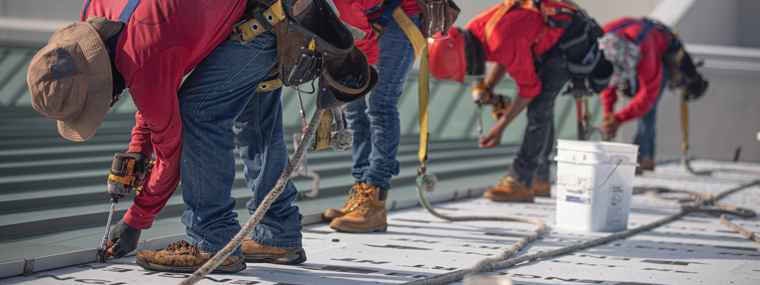
Florida’s 25 Percent Replacement Rule and How It Impacts Roof Repairs
By Casey Crowther / Published December 2019

Hurricane Irma caused an estimated $50 billion in damage, according to the National Oceanic and Atmospheric Administration, making it the fifth-costliest U.S. hurricane on record.
Hurricanes Michael, Matthew, and Hermine also didn’t take it easy on Florida, and neither did countless tropical storms that have hit the peninsula in recent years.

A large chunk of storm damage estimates is attributed to roof damage. That’s to be expected because roofs bear the full wrath of hurricane-force winds, and they’re not cheap to fix.
What perplexes many people, however, is why some homes and businesses had their roofs quickly replaced or repaired, while others sat in disrepair for months on end.
Why aren’t they all fixed right away?
After a storm, many roofers certainly are overwhelmed with more jobs than they could possibly handle, but that’s not the only reason. A chief sticking point in fixing a storm-damaged roof often boils down to who is going to pay for it—the property owner or the insurance company.

Florida law stands at the center of that debate.
According to the Florida Building Code, “not more than 25 percent of the total roof area or roof section of any existing building or structure shall be repaired, replaced, or recovered in any 12 month period unless the entire roofing system or roof section conforms to the requirements of this code.” This means that if more than one fourth of a roof was damaged, insurance companies might be liable to cover the cost of a partial or full roof replacement. Property owners would need to pay their deductible, which is either a flat amount before insurance kicks in or a percentage based on the total repair cost, and the insurance company would pay the rest.
If less than 25 percent of a roof was damaged, insurance companies can still pick up the cost of repairs after the deductible is met. Obviously, property owners would like the official damage estimate to exceed 25 percent, while it would stand to reason that insurance companies would like appraisals to fall below that mark.

Deductibles can range from a few thousand dollars to tens of thousands, depending on the size of a property. Considering many residents and businesses lose income immediately after a storm, simply cutting a check for a large deductible isn’t always in the budget. That’s why some roofs are fixed right away and why some might still have a blue tarp to this day.
Hurricane damage is unpredictable, but there are steps that property owners and property managers can take to ensure the post-hurricane insurance claims process isn’t as painful:
- Pre-hurricane prep: Winds can dislodge roofing materials, but a lot of roof damage is caused by flying debris. Trim trees near any structure and securely store potential flying objects located on the property.
- Photo evidence: It’s important to have before-and-after photos to document the condition of a roof. Insurance companies appreciate documentation when evaluating claims, and photo evidence eliminates potential arguments that a roof was already damaged before the storm hit.
- Inspection reports: Written and dated inspection reports from a reputable, certified inspector demonstrate a property owner’s commitment to proper maintenance and offer another piece of evidence outlining the roof’s condition before a storm.
- Annual maintenance plan:Beyond hurricane insurance policies, roofing materials and installation might still be under warranty. However, warranties likely require regular maintenance to remain valid, so annual maintenance plans can provide peace of mind.
Many roofing companies work hand-in-hand with property insurance companies during the claims process. A skilled roofing company knows what is needed to process a claim and will provide detailed inspection reports and itemized estimates to maximize a claim.
Florida will have another hurricane or tropical storm, so it’s better to know what is covered and what is not before a storm strikes.
Casey Crowther
President, Target Roofing & Sheet Metal
Casey Crowther is a fifth-generation roofer and president of Target Roofing & Sheet Metal, a licensed and insured commercial roofing specialist headquartered in Fort Myers. For more information, please visit TargetRoofers.com or call (239) 334-7496.




